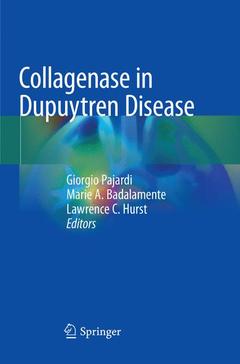Description
Collagenase in Dupuytren Disease, Softcover reprint of the original 1st ed. 2018
Coordinators: Pajardi Giorgio, Badalamente Marie A., Hurst Lawrence C.
Language: English
Subject for Collagenase in Dupuytren Disease:
Publication date: 01-2019
Support: Print on demand
Publication date: 08-2018
Support: Print on demand
Description
/li>Contents
/li>Biography
/li>Comment
/li>
This book offers detailed guidance on the use of collagenase, or enzymatic fasciotomy, as a nonsurgical treatment for Dupuytren?s contracture and explains its role in relation to the other forms of treatment, including open fasciectomy, needle aponeurotomy, and lipofilling. Clear guidance is provided on technique, current indications, and off-label usage. With the help of tips and tricks from leading experts, the reader will learn how to personalize the procedure to meet the needs of individual patients. Advice is also provided on all aspects of rehabilitation, which is a key determinant of treatment outcome. Collagenase treatment of Dupuytren?s disease has the benefits of low invasiveness and rapid patient recovery and achieves reasonable recurrence-free periods. It is especially valuable in patients with rapid recurrence following surgery. In documenting and appraising every aspect of its use, this book will be of value for all who treat patients with Dupuytren?s disease, including hand surgeons, orthopedists, plastic surgeons, physiatrists, and physiotherapists.
Dr. Giorgio Eugenio Pajardi is Professor of Plastic and Reconstructive Surgery at Università degli Studi di Milano, Milan, Italy, where he is director of various courses on hand surgery and rehabilitation. While hand surgery is his principal field of interest, he is also a specialist in peripheral nerve surgery, neuro-orthopedic surgery, and reconstructive microsurgery. His mentors were in Italy Professor Ezio Morelli and outside Professor Guy Foucher, and Professor Pajardi adheres to the French School’s emphasis on hand surgery and hand rehabilitation as synergistic pillars of treatment. Professor Pajardi is the author of approximately 170 national and international publications and is a regular lecturer at national and international congresses. He is a member of the Italian Society of Plastic and Reconstructive Surgery, the Italian Society of Hand Surgery, and the International Federation of Hand Surgery Societies. He is also President of Centro Studi Mano, a culturalnot for profit foundation whose statutory goal is to promote teaching and improve career pathways for young students.
Dr. Marie Badalamente is Professor of Orthopaedics at Stony Brook University Medical Center, Stony Brook, New York, USA. She is the author of over 68 publications and 150 abstract/presentations. Along with Dr. Hurst, she is the inventor of collagenase clostridium histolyticum (CCH) in the treatment of Dupuytren disease through the Food and Drug Administration clinical trials process in the USA. As CCH is potentially a multi-use drug, Dr. Badalamente continues her research in it’s use for other medical indications, such as, adhesive capsulitis (frozen shoulder). Dr. Badalamente is a member of the American Society for Surgery of the Hand, American Acadmeny of Orthopaedic Surgeons and the Orthopaedic Research Society.
Dr. Lawrence C. Hurst is Professor and Chairman of the Department of Ort




